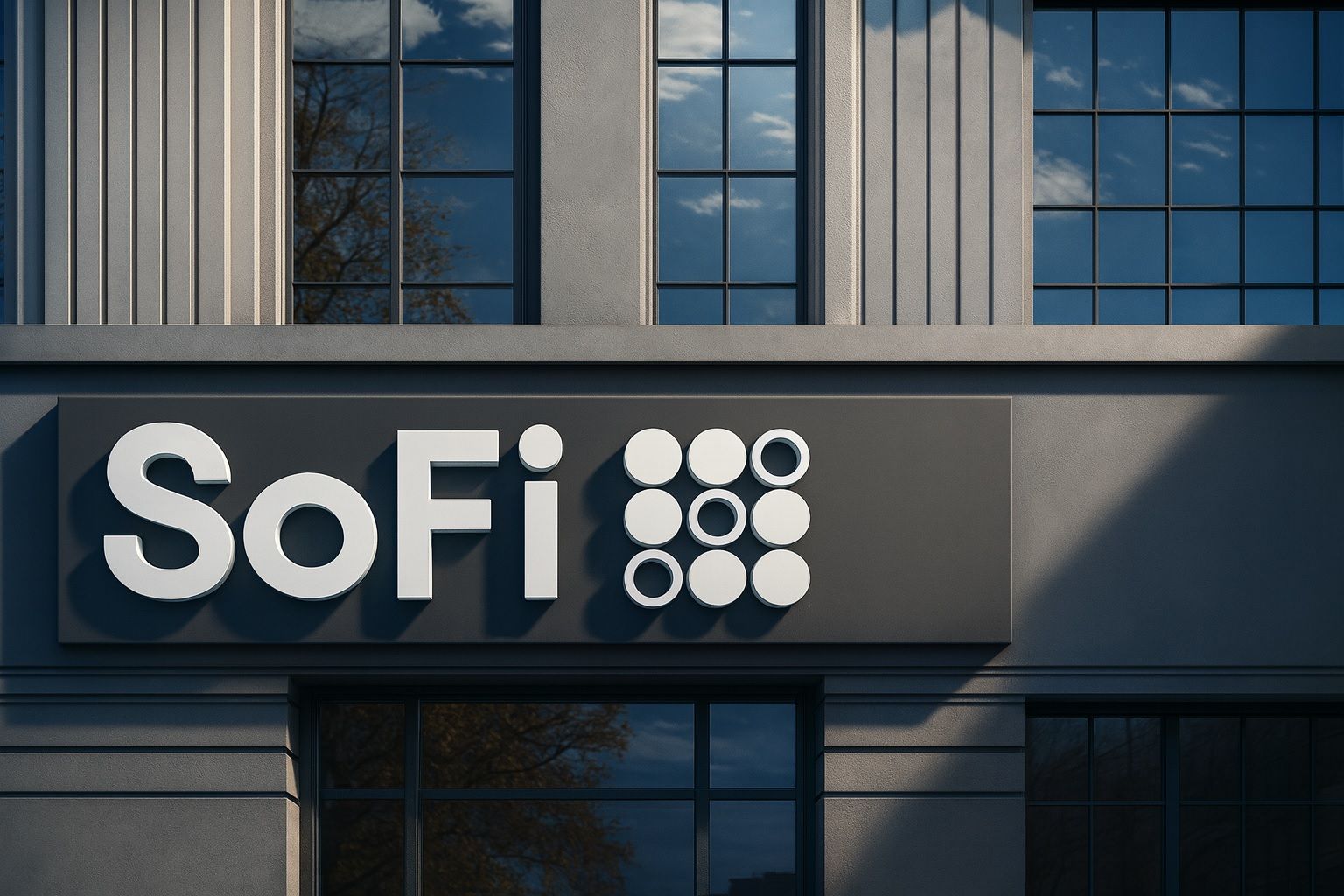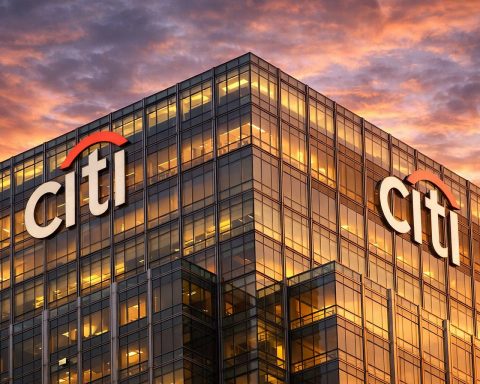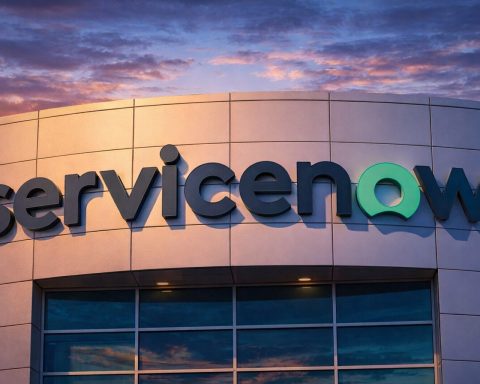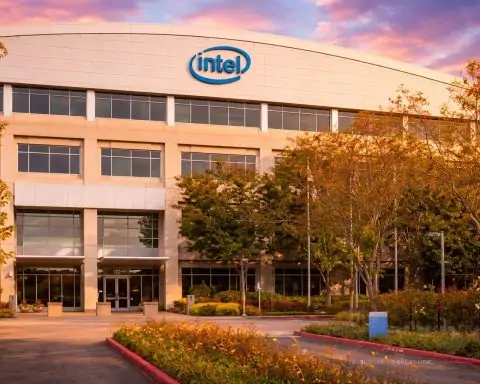- Rebounding Share Price: SoFi Technologies (NASDAQ: SOFI) stock jumped nearly 8% on October 20, rebounding from last week’s dip [1]. After a volatile few weeks, shares trade around the high-$20s – up roughly 70% year-to-date and ~230% higher than a year ago [2]. The stock hit a 52-week high of about $30.30 in late September before pulling back [3] (52-week low was ~$7.57 [4]).
- Upcoming Earnings Catalyst: SoFi will report Q3 2025 earnings on Oct. 28, and expectations are high. Analysts forecast ~$880 million in revenue and EPS of ~$0.08 for the quarter [5] – about 28% revenue growth and 60% higher earnings year-over-year. The company already beat estimates in Q2 (posting $0.08 EPS vs. $0.06 expected) and raised full-year revenue guidance to ~$3.37 B (+30% YoY) after that beat [6].
- New Fintech Offerings: SoFi is rapidly expanding its product suite. In early October it launched commission-free options trading for retail investors (allowing beginners to trade covered calls and puts at no cost) [7]. It also rolled out a new AI-focused ETF (NASDAQ: AGIQ) in September targeting next-gen tech companies [8]. On the crypto front, CEO Anthony Noto revealed plans to enable blockchain-based international transfers via the Bitcoin Lightning Network by late 2025 (piloting in Mexico), and even to launch an FDIC-insured stablecoin once regulators permit [9].
- Analyst Upgrade & Outlook: Zacks Investment Research upgraded SoFi to a “Buy” on Oct. 20, citing “growing optimism” about the company’s earnings outlook [10]. Wall Street remains divided, however. Bulls point to SoFi’s surging growth and improving profitability, while bears warn the stock’s valuation (nearly 50× forward earnings) already prices in a lot of good news [11] [12]. The consensus rating is Hold with an average price target around $21 [13] – below the current price.
- Fintech Sector Tailwinds: SoFi’s rise comes amid a broader fintech rally. The stock has far outpaced traditional fintech peers like PayPal and Block in 2025, and even fellow “neobanks” and consumer finance apps. For instance, buy-now-pay-later lender Affirm and trading app Robinhood have also soared this year, though they still struggle with profitability or slowing growth [14]. Uniquely, SoFi boasts a national bank charter and seven consecutive profitable quarters, giving it an edge in funding and credibility [15] [16]. Industry observers say SoFi is emerging as a leader in the digital banking space, but it faces intense competition from both fintech rivals and big banks.
Stock Rebound After Volatile Weeks
SoFi’s stock has been on a roller-coaster. After tripling in the past year, climbing from single-digit prices to a record ~$30 in late September, the fintech favorite hit turbulence [17]. In the final weeks of September and into early October, profit-taking and broader market jitters knocked SOFI off its highs. The shares slid about 10–15% from their peak, even logging a 5% one-day drop on Oct. 16 to around $26.60 [18]. “Most buyers are already in,” one analyst quipped during the pullback – cautioning that the pool of new investors willing to propel the stock higher may be dwindling [19].
This week, however, SoFi showed it’s not out of steam. On Monday (Oct. 20) the stock bounced sharply, gaining roughly 7–8% intraday [20]. Traders attributed the pop partly to the Zacks upgrade and optimism ahead of earnings. By afternoon, SOFI hovered around the upper-$20s per share, recouping a chunk of its recent losses [21]. Even after the volatility, SoFi remains up about 70% in 2025 – dramatically outperforming the S&P 500 and most bank stocks [22]. Its current ~$28 price also gives SoFi a market capitalization near $30 billion, putting it on par with or above many regional banks that hold far more in assets [23]. This underscores the market’s confidence in SoFi’s growth story, but also the rich valuation being assigned to a still-young financial firm.
Earnings on Tap and Strong Growth Momentum
The next big catalyst is just around the corner: Q3 2025 earnings are due before market open on October 28. Analysts are looking for another quarter of robust growth [24]. Consensus estimates call for roughly $880 million in revenue (up ~28% year-over-year) and $0.08 in earnings per share (~+60% YoY) [25]. SoFi’s management will also host a conference call that morning, and investors expect updates on key business metrics and 2025 guidance.
If recent history is any guide, SoFi could deliver positive surprises. Last quarter, the company blew past expectations, posting $0.08 in EPS (versus $0.06 expected) on record revenue growth [26]. Q2 2025 revenue jumped 44% year-over-year, as SoFi added customers at a torrid pace and saw strength across its lending and financial services segments [27] [28]. The company added about 850,000 new members in Q2 (up 34% YoY) for a total of 11.7 million members using 17.1 million products – meaning the average customer now has multiple SoFi products [29]. This cross-selling is driving “financial super-app” engagement: SoFi’s users often start with one service (like a high-yield savings account or loan) and later adopt others (investing, credit card, etc.), boosting lifetime value.
Notably, SoFi’s non-lending financial services arm (which includes checking/savings, investing, credit cards, etc.) is growing even faster than its core loans. In Q2, financial services revenue surged 106% and contribution profit jumped 241% to $188 million – approaching the profit generated by SoFi’s lending division [30]. This reflects the payoff from SoFi’s strategy of using attractive banking products to reel in customers and then upselling higher-margin offerings. Meanwhile, the bread-and-butter lending business is rebounding after a period of interest-rate pressure. Personal loan originations were up 66% in Q2, and student loan refinancing – a segment hit hard by the pandemic pause – climbed 35% as borrowers resumed payments [31]. CEO Anthony Noto has said he envisions SoFi eventually becoming one of America’s top-10 financial institutions, and the latest results show continued progress on that lofty goal [32].
With those tailwinds, SoFi’s management raised its full-year outlook in July, now targeting roughly $3.4 billion in 2025 revenue (about +30% vs. 2024) [33]. Importantly, SoFi has also achieved GAAP profitability in recent quarters – a milestone few fintechs have reached. The company has notched seven straight profitable quarters (GAAP) as of mid-2025 [34], and it expects this trend to continue. For the full year 2025, the consensus earnings forecast is around $0.32 per share [35] (roughly flat with last year’s EPS, as SoFi reinvests for growth). In other words, SoFi is now solidly in the black, but investors will be watching how quickly those profits scale from here. Any update to 2025 guidance or hints about 2026 targets on the upcoming earnings call could sway the stock. (For reference, SoFi’s own long-term plan aims for ~$0.55–$0.80 EPS by 2026 if all goes well [36].)
New Offerings Fueling Fintech Expansion
SoFi hasn’t been content to rest on its laurels – the company has been aggressively expanding its platform with new products and features, keeping its fintech super-app at the cutting edge. In the past few weeks alone, SoFi rolled out several notable offerings:
- Stock Options Trading: In early October, SoFi launched commission-free options trading for eligible users [37]. This allows retail investors (even beginners) to trade basic options strategies (like covered calls and cash-secured puts) directly in the SoFi app with zero commissions or contract fees. The move – first reported by Bloomberg – opens a new avenue for SoFi’s customers to invest and signals the company’s push into areas traditionally dominated by brokerages. By eliminating fees, SoFi is clearly aiming to attract younger, options-curious traders and keep them engaged on the platform.
- AI-Focused ETF: SoFi also debuted a new exchange-traded fund, the SoFi “AGIG” ETF (NASDAQ: AGIQ), in September [38]. This fund is centered on “agentic” AI – essentially companies poised to benefit from next-generation artificial intelligence innovations (it reportedly includes names like Tesla and Nvidia). Launching an in-house ETF is another way for SoFi to broaden its investing lineup and capture interest from tech-savvy investors. It builds on SoFi’s existing family of ETFs and reinforces the brand’s image as a forward-looking fintech innovator.
- Crypto and Payments Innovations: Perhaps most eye-catching, SoFi is doubling down on cryptocurrency and blockchain as part of its services. CEO Anthony Noto announced plans to enable blockchain-based international money transfers by late 2025 via a partnership with Lightning Network startup Lightspark [39]. The pilot program (starting with remittances to Mexico) promises near-instant, low-cost cross-border payments using Bitcoin’s Lightning rails. If successful and expanded, this could make SoFi a go-to app for cheap global transfers, challenging incumbent remittance providers. Noto even revealed that SoFi intends to launch its own stablecoin (a crypto tied to fiat currency and insured by the FDIC) once regulators give the green light [40]. These moves, Noto says, will give members “faster, smarter, and more inclusive access” to their money through cutting-edge tech [41]. In short, SoFi is betting that integrating crypto functionality will enhance its appeal to younger users and keep it at the forefront of fintech innovation.
- Galileo Platform Partnerships: On the B2B side, SoFi’s Galileo unit – which provides banking and payments infrastructure to fintechs and other companies – scored a notable partnership. Galileo joined Amazon’s AWS Partner Network in mid-October, making its cloud-based payment processing platform available through AWS [42]. This step will help Galileo reach a wider range of banks, fintech startups, and brands that want to build modern financial products on Amazon’s cloud. It underscores how SoFi’s tech platform is extending its footprint globally. Galileo has been a quiet growth driver for SoFi, processing hundreds of millions of accounts, and was recently recognized as a top digital payments provider [43]. Along with this partnership, Galileo had a leadership shakeup: its long-time CEO Derek White stepped down in October after presiding over record growth (hitting the “Rule of 40” in revenue/profitability), and SoFi appointed CFO Bill Kennedy as the new Galileo CEO [44]. The focus now is on scaling Galileo’s client base with help from big cloud partners.
These new offerings and initiatives illustrate SoFi’s overarching strategy – build an all-in-one financial ecosystem that appeals to the next generation of consumers. By continuously adding capabilities (from stock trading to crypto to third-party B2B services), SoFi increases its touchpoints with users and potential revenue streams. It’s a playbook similar to other “super-app” aspirants, and so far SoFi’s execution has been strong. The key question is whether these expansions will translate into sustained user growth and higher margins in coming quarters. Investors will be listening for early traction metrics (e.g. options trading volumes, crypto transfer usage, Galileo client wins) on upcoming calls.
Analyst Upgrades and Diverging Views on Valuation
SoFi’s dramatic run in 2025 has drawn a wide range of opinions on Wall Street. The stock’s nearly 3× surge over the past year has some analysts pounding the table with bullish optimism – and others urging caution, citing the rich valuation and macro risks. This split in sentiment was on full display in recent weeks:
On the bullish side, several analysts see further upside for SoFi and have been raising their targets. In mid-September, Mizuho’s Dan Dolev – one of the most vocal SoFi bulls – reiterated his Buy rating and hiked his price target to $31 (from $26) [45]. Dolev argues that SoFi’s growth story is actually entering a “new phase” of acceleration, with the potential for interest rate cuts in 2025 to turbocharge SoFi’s lending volumes and margins [46]. He points out that SoFi’s core metrics remain very robust – for example, revenue up 44% YoY and record member growth in Q2 [47] – suggesting the company can continue scaling rapidly. Similarly, Needham & Co. recently raised its target to $29 (from $25) while affirming a Buy, citing improving funding conditions for SoFi’s digital lending business [48]. And after meeting with SoFi’s management, analysts at William Blair said they came away “confident in the company’s growth outlook,” maintaining an Outperform (equivalent to Buy) rating [49]. Overall, pro-SOFI analysts highlight the company’s unique positioning (as a tech-driven bank), its expanding product suite, and the massive market opportunity in disrupting traditional banks. They believe SoFi can sustain 30%+ annual revenue growth for years, eventually “growing into” its valuation as earnings multiply [50]. Indeed, management’s internal targets for 2026 (>$0.50 EPS) lend credence to the idea that current prices could look reasonable in hindsight if SoFi delivers [51].
On the bearish side, skeptics contend that SoFi’s stock has run too far, too fast. After such a parabolic rally, some warn that much of the good news is already baked in. Morgan Stanley has been one high-profile skeptic – the firm earlier assigned an Underweight (Sell-equivalent) rating and values SoFi closer to $18/share, arguing the ~250% yearly gain was “overextended” [52]. Morgan Stanley cautions that if interest rates fall next year (as many expect), SoFi’s competitive edge from its low-cost deposit funding could narrow, potentially compressing margins [53]. Similarly, Compass Point analysts have one of the Street’s lowest targets at $12, seeing the stock as significantly overvalued at present levels [54]. The bears also note that SoFi trades at lofty multiples – roughly 47× forward earnings and over 9× sales by some measures [55] – more akin to a hyper-growth tech company than a bank. That leaves little room for error if SoFi’s growth slows or if it stumbles operationally. “One of the deepest ironies” of a hot stock, notes one columnist, is that its very success begets new challenges – investors start to fear “holding the bag” if they buy in at the top and growth then falters [56]. In that vein, some analysts suggest “most buyers are already in” on SoFi’s story, implying it could be tough to find the next leg of incremental demand to drive shares higher [57].
For now, the consensus on Wall Street lands in the middle. According to MarketBeat and other aggregators, the average rating is a Hold and the mean price target is around $20–$22 [58]. That’s roughly 20% below the current stock price, suggesting analysts on balance see limited upside after the huge run. Of course, price targets can lag momentum – and SoFi has already blown past many earlier targets this year. The recent Zacks Rank upgrade to “Buy” (Rank #2) on Oct. 20 adds another vote of confidence on the positive side [59]. Zacks noted that SoFi’s earnings estimates have been trending upward (the consensus EPS for 2025 has risen about 15% in the past 3 months) [60], a sign of improving fundamentals. In Zacks’ system, rising estimates earned SoFi a spot in the top 20% of stocks, indicating it “might move higher in the near term” as investors recognize the better outlook [61] [62]. This quantitative bullish signal contributed to Monday’s rally. Going forward, it’s clear sentiment is split – any new information (from earnings or elsewhere) that reinforces either the bull or bear case could sway the stock significantly, given SoFi’s volatility (the stock’s beta is ~1.9, nearly twice the market average [63]).
Fintech Frenzy Lifts SoFi and Peers
SoFi’s surge in 2025 hasn’t happened in isolation – it comes amid a broader fintech renaissance this year. After a brutal 2022–2023 for many fintech and “neobank” stocks, investors have returned to the space in force, encouraged by improving economics and growth. Fintech and digital banking names overall have rallied sharply, though few as much as SoFi. For context, Affirm – a buy-now-pay-later specialist – saw its stock price quintupling over the past year (trading recently around $74 [64]), and Robinhood – the popular trading app – climbed back into favor, skyrocketing to the $140 range [65]. These are remarkable comebacks for companies that were deeply out of favor not long ago. However, their fundamentals tell a cautionary tale: Affirm is still struggling to achieve consistent profits, and Robinhood’s user growth has leveled off post-pandemic [66]. In contrast, SoFi stands out as one of the few consumer fintechs that’s both growing at scale and profitable [67]. Its diversified model (spanning lending, banking, brokerage, and tech services) gives it multiple revenue streams and arguably a more sustainable foundation.
Competition remains fierce. SoFi’s all-in-one model pits it against a who’s-who of financial players: not just fintech upstarts like Chime (the private neobank) and Coinbase (in crypto trading), but also established giants. Traditional banks (e.g. JPMorgan Chase) have rolled out high-yield online accounts and slick mobile apps to retain younger customers, while legacy fintechs like PayPal and Block (Square) are expanding their offerings to emulate some of SoFi’s “super-app” features [68]. SoFi’s edge, bulls argue, is that it’s vertically integrated – it owns a bank charter, does its own lending, and runs its own tech stack via Galileo [69] [70]. That means it can offer extremely competitive rates (funding loans with its growing base of customer deposits) and quickly roll out new products without waiting on third parties. Indeed, SoFi’s ability to add about 500,000+ new members each quarter in 2025 – an expansion pace legacy banks could only dream of – shows the appeal of its model to Millennials and Gen Z users hungry for digital-first banking [71].
Still, the fintech gold rush of 2025 has lifted all boats to some extent, and valuations are in focus. Despite recent stock gains, many incumbent fintechs trade at far lower multiples than SoFi. PayPal, for instance, commands around 12× forward earnings, and Block about 21×, versus ~50× for SoFi [72]. Even other online lenders like LendingClub (which has a bank charter as well) trade closer to 23× earnings [73]. By comparison, SoFi’s premium valuation implies investors expect extraordinary growth and market share gains to continue. There’s precedent for richly valued disruptors eventually “growing into” their multiples – Amazon and Tesla are oft-cited examples – but not every fintech will follow that trajectory. SoFi will need to execute nearly flawlessly, continuing to win users and keep credit losses low, to justify the market’s optimism. In the meantime, the fintech sector’s momentum and the buzz around neobanks have clearly benefited SoFi’s narrative. As long as growth stays red-hot, many investors seem willing to pay up for the “next big thing” in banking. But any stumble by SoFi or a souring of sentiment toward fintech high-fliers could bring swift corrections – as seen by the stock’s double-digit swings on relatively minor news.
Looking Ahead: Opportunities and Risks
As we head into the end of 2025, SoFi finds itself at a pivotal juncture. The company has immense opportunities on the horizon, but also no shortage of risks to navigate. Forward-looking investors are zeroing in on a few key factors that could determine SOFI’s next chapter:
- $1.6 Trillion Student Loan Catalyst: One under-the-radar opportunity gaining attention is the potential privatization of federal student loans. A recent report suggested the U.S. Treasury might consider selling off federal student loan portfolios (totaling ~$1.6 trillion) to private lenders [74]. Such a move – floated in some policy circles – would be a game changer for SoFi. As a former student-loan refi specialist, SoFi could seize a huge market if government-held loans are opened up to refinancing. (Notably, members of the previous U.S. administration had proposed similar ideas [75].) While there’s no guarantee this will happen, the mere prospect represents a massive TAM (total addressable market) expansion for SoFi’s bread-and-butter business. After enduring a drought during the pandemic loan payment freeze, SoFi’s refinancing arm is already rebounding; a policy shift of this magnitude could accelerate it dramatically. Investors will be watching for any indications of legislation or executive action on this front in 2026.
- Macro Wildcards – Rates and Economy: The interest rate environment remains a double-edged sword for SoFi. On one hand, many expect the Federal Reserve to begin cutting rates in 2025, especially if inflation cools and economic growth slows. Rate cuts could reignite demand for SoFi’s loans – spurring a wave of refinancing for student loans, mortgages, and personal loans, which plays directly into SoFi’s strength [76]. Bulls like Mizuho’s Dolev cite this as a major tailwind for next year [77]. However, if rates don’t fall (or not as fast as hoped), SoFi could face headwinds: higher rates make borrowing more expensive, potentially dampening loan growth, and they also raise SoFi’s own cost of attracting deposits (e.g. the 4%+ savings APY it offers to lure customers). Economic conditions are another factor – so far U.S. consumers have been resilient, and SoFi’s credit performance has been stable. But in a downturn or recession, loan defaults could rise, testing SoFi’s underwriting and cutting into profits [78]. As a relatively young lender, SoFi hasn’t been through a severe credit cycle at its current scale, so that remains an overhang. The company has built significant loan loss reserves and emphasizes high-income borrowers, but a sharp economic contraction would be a major challenge.
- High Expectations and Execution Risk: Perhaps the biggest risk is simply the lofty bar SoFi now has to clear. With the stock trading at 9–10× revenue and ~4.5× book value [79], investors are clearly betting on rapid growth and flawless execution. Any slip – whether a bad earnings miss, a spike in delinquencies, or even a slowdown in new customer additions – could trigger a sharp re-rating of the shares. SoFi’s management will need to continue delivering strong results quarter after quarter to maintain market confidence. The good news is that they’ve done so for the past two years, consistently exceeding growth targets and turning the company profitable ahead of schedule. SoFi’s brand among young professionals is strong, its product pipeline is brimming, and its diversified model provides multiple revenue levers. But as one analyst put it, at ~50× earnings “little margin for error” remains [80]. Bulls and bears will be closely analyzing the upcoming Q3 report for any hints of either accelerating momentum or emerging cracks.
- Competition and Regulatory Hurdles: Finally, SoFi must keep an eye on competitors and regulators. Fintech is a fast-moving arena – new entrants (or big tech companies) could always attempt to disrupt SoFi’s niche. Large banks, for their part, are unlikely to sit idle as upstarts poach market share; we may see more competitive offers (like higher deposit rates or zero-fee trading) aimed at retaining customers. On the regulatory side, SoFi’s expansion into areas like crypto and its bank activities means it operates under multiple overseers (OCC, FDIC, SEC, etc.). Any tightening of fintech regulations, crypto crackdowns, or unfavorable banking rules changes could pose challenges [81]. So far, SoFi has navigated the landscape adeptly – even shutting down and later rebooting its crypto services in response to evolving rules [82] – but it’s an area to watch. Being a bank as well as a fintech, SoFi must wear many hats in compliance.
The bottom line: SoFi Technologies has rapidly transformed from a niche student lender into a diversified fintech powerhouse – and its stock has correspondingly transformed into a market darling over the past year. The company’s blend of Silicon Valley tech innovation and Wall Street-style finance is resonating with consumers and investors alike, driving exceptional growth [83]. Going forward, SoFi’s story will be defined by whether it can keep up this momentum. There are plenty of reasons to be optimistic: a highly engaged (and growing) customer base, new product verticals coming online, and potential macro tailwinds like rate cuts. It’s easy to see why SoFi bulls are excited about the next few years – some even compare its disruptive potential in finance to Amazon’s in retail or Tesla’s in autos. Yet at the same time, the high-flying stock price means SoFi has a lot to prove. Even modest hiccups could bring volatility. All eyes are now on the Oct. 28 earnings to gauge if SoFi can meet the market’s lofty expectations. For now, the fintech upstart has the Street’s attention: SoFi has become one of the most talked-about stocks in 2025’s market rally, embodying both the promise and the peril of investing in disruptive growth companies. Investors interested in SoFi should buckle up – the ride is likely to stay exciting. In the coming weeks, expect a showdown of narratives between bulls and bears as SoFi opens its books and provides guidance on its future [84]. The fintech revolution that lifted SoFi in 2025 shows no sign of slowing, but only time will tell if the company can truly live up to the hype in 2026 and beyond.
Sources: Recent news and analysis from TechStock² (ts2.tech) [85] [86] [87], FX Leaders [88], Zacks Investment Research [89] [90], Motley Fool [91] [92], Business Wire [93], and other market data as of Oct. 20, 2025.
References
1. finviz.com, 2. ts2.tech, 3. ts2.tech, 4. ts2.tech, 5. ts2.tech, 6. ts2.tech, 7. ts2.tech, 8. ts2.tech, 9. ts2.tech, 10. finviz.com, 11. ts2.tech, 12. ts2.tech, 13. ts2.tech, 14. ts2.tech, 15. ts2.tech, 16. ts2.tech, 17. ts2.tech, 18. ts2.tech, 19. ts2.tech, 20. finviz.com, 21. finviz.com, 22. ts2.tech, 23. ts2.tech, 24. ts2.tech, 25. ts2.tech, 26. ts2.tech, 27. ts2.tech, 28. finviz.com, 29. finviz.com, 30. finviz.com, 31. finviz.com, 32. finviz.com, 33. ts2.tech, 34. ts2.tech, 35. finviz.com, 36. ts2.tech, 37. ts2.tech, 38. ts2.tech, 39. ts2.tech, 40. ts2.tech, 41. ts2.tech, 42. www.businesswire.com, 43. www.businesswire.com, 44. ts2.tech, 45. ts2.tech, 46. ts2.tech, 47. ts2.tech, 48. ts2.tech, 49. ts2.tech, 50. ts2.tech, 51. ts2.tech, 52. ts2.tech, 53. ts2.tech, 54. ts2.tech, 55. ts2.tech, 56. ts2.tech, 57. ts2.tech, 58. ts2.tech, 59. finviz.com, 60. finviz.com, 61. finviz.com, 62. finviz.com, 63. ts2.tech, 64. ts2.tech, 65. ts2.tech, 66. ts2.tech, 67. ts2.tech, 68. finviz.com, 69. finviz.com, 70. ts2.tech, 71. ts2.tech, 72. ts2.tech, 73. ts2.tech, 74. ts2.tech, 75. finviz.com, 76. ts2.tech, 77. ts2.tech, 78. ts2.tech, 79. finviz.com, 80. ts2.tech, 81. ts2.tech, 82. finviz.com, 83. finviz.com, 84. ts2.tech, 85. ts2.tech, 86. ts2.tech, 87. ts2.tech, 88. www.fxleaders.com, 89. finviz.com, 90. finviz.com, 91. finviz.com, 92. finviz.com, 93. www.businesswire.com










